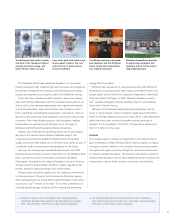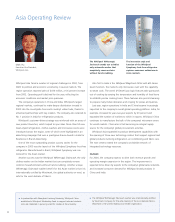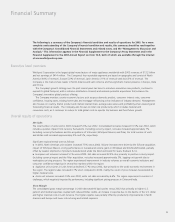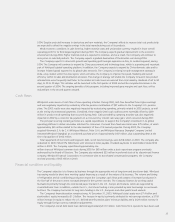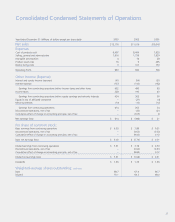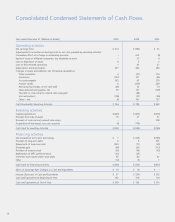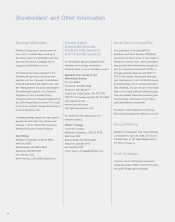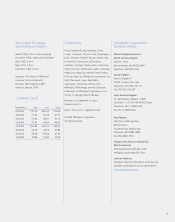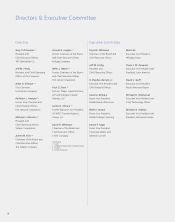Whirlpool 2003 Annual Report Download - page 28
Download and view the complete annual report
Please find page 28 of the 2003 Whirlpool annual report below. You can navigate through the pages in the report by either clicking on the pages listed below, or by using the keyword search tool below to find specific information within the annual report.
26
to reduce the Company’s indebtedness.
The Company believes that its capital resources and liquidity position at December 31, 2003, coupled with its planned
cash flow generated from operations in 2004, are adequate to support higher capital spending, a higher dividend payment
and to meet anticipated business needs to fund future growth opportunities.
Other matters
Pursuant to the Company’s stock repurchase program previously authorized by the Board of Directors, the Company
repurchased a combined total one million shares of Whirlpool common stock in the open market subsequent to December
31, 2003, at an aggregate purchase price of $75 million.
In December 2003, Whirlpool Corporation’s Board of Directors announced a first quarter 2004 dividend of 43 cents per
share, a 26% increase from the fourth quarter 2003 dividend of 34 cents per share. The dividend is payable on March 15,
2004, to holders of record at the close of business on February 27, 2004. If continued, the dividend will increase the
Company’s annual dividend payments by approximately $24 million to $118 million.
While lower discount rates increased Whirlpool’s pension obligations during 2003, improvement in equity market
performance during the year significantly increased the value of pension fund assets. Whirlpool also contributed approximately
$103 million after tax to the pension plans during 2003, of which $97 million was voluntary. As a result of these actions,
the unfunded obligation declined and the Company reduced its minimum pension liability equity charge by $118 million,
after tax, to $38 million during 2003. At December 31, 2003, the Company’s defined benefit pension plans still remain
underfunded on a combined basis.
The Company recognized consolidated pre-tax pension cost (credits) of $78 million, $(37) million and $(70) million in
2003, 2002 and 2001, respectively. The assumptions used in determining its obligation under its U.S. pension plans at the
end of 2003 included an expected return on assets of 8.75%, the same as at the end of 2002, and a discount rate of
6.00%, versus 6.75% at the end of 2002. The Company’s expected return on assets of 8.75% is based on historical
market returns between 1926 and 2003 applied to its target allocation of plan assets. The annualized discount rate
approximates Moody’s Aa corporate bond rate at the measurement date. The Company uses a measurement date of
December 31. The Company currently expects that U.S. pension expense for 2004 will be approximately $60 million based
upon an asset return rate of 8.75% and a lower discount rate of 6.00% compared to pension cost of $63 million in 2003.
Consolidated pension cost in 2004 is anticipated to be approximately $72 million compared to $78 million in 2003.
Market risk
The Company is exposed to market risk from changes in foreign currency exchange rates, domestic and foreign interest
rates, and commodity prices, which can affect the Company’s operating results and overall financial condition. Whirlpool
manages its exposure to these market risks through its operating and financing activities and, when deemed appropriate,
through the use of derivative financial instruments. Derivative financial instruments are viewed as risk management tools
and are not used for speculation or for trading purposes. Derivative financial instruments are entered into with a diversified
group of investment grade counterparties to reduce the Company’s exposure to nonperformance on such instruments. The
Company’s sensitivity analysis reflects the effects of changes in market risk but does not factor in potential business risks of
the counterparties or appropriate use of instruments.
Whirlpool uses foreign currency forward contracts and currency swaps to hedge the price risk associated with firmly
committed and forecasted cross-border payments and receipts related to its ongoing business and operational financing
activities. Foreign currency contracts are sensitive to changes in foreign currency exchange rates.





